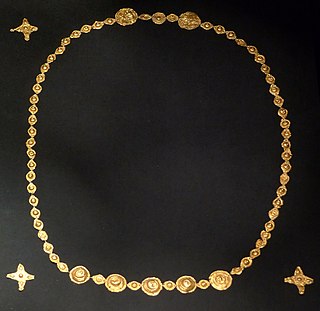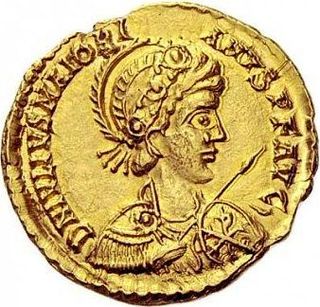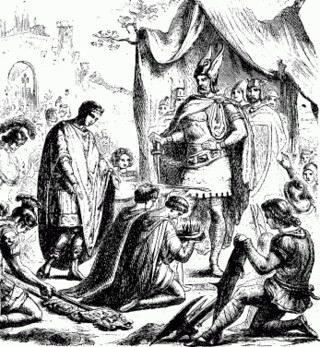The 450s decade ran from January 1, 450, to December 31, 459.

Year 458 (CDLVIII) was a common year starting on Wednesday of the Julian calendar. At the time, it was known as the Year of the Consulship of Maiorianus and Leo. The denomination 458 for this year has been used since the early medieval period, when the Anno Domini calendar era became the prevalent method in Europe for naming years.

The Vandals were a Germanic people who first inhabited what is now southern Poland. They established Vandal kingdoms on the Iberian Peninsula, Mediterranean islands, and North Africa in the fifth century.

Marcian was Roman emperor of the East from 450 to 457. Very little of his life before becoming emperor is known, other than that he was a domesticus who served under the commanders Ardabur and his son Aspar for fifteen years. After the death of Emperor Theodosius II on 28 July 450, Marcian was made a candidate for the throne by Aspar, who held much influence because of his military power. After a month of negotiations Pulcheria, Theodosius' sister, agreed to marry Marcian. Zeno, a military leader whose influence was similar to Aspar's, may have been involved in these negotiations, as he was given the high-ranking court title of patrician upon Marcian's accession. Marcian was elected and inaugurated on 25 August 450.

Ricimer was a Romanized Germanic general who effectively ruled the remaining territory of the Western Roman Empire from 456 after defeating Avitus, until his death in 472, with a brief interlude in which he contested power with Anthemius. Deriving his power from his position as magister militum of the Western Empire, Ricimer exercised political control through a series of puppet emperors. Ricimer's death led to unrest across Italy and the establishment of a Germanic kingdom on the Italian Peninsula.

Majorian was the Western Roman emperor from 457 to 461. A prominent commander in the Western military, Majorian deposed Avitus in 457 with the aid of his ally Ricimer at the Battle of Placentia. Possessing little more than Italy and Dalmatia, as well as some territory in Hispania and northern Gaul, Majorian campaigned rigorously for three years against the Empire's enemies. In 461, he was murdered at Dertona in a conspiracy, and his successors until the Fall of the Empire in 476 were puppets either of barbarian generals or the Eastern Roman court.

Procopius Anthemius was the Western Roman emperor from 467 to 472. Born in the Eastern Roman Empire, Anthemius quickly worked his way up the ranks. He married into the Theodosian dynasty through Marcia Euphemia, daughter of Eastern emperor Marcian. He soon received a significant number of promotions to various posts, and was presumed to be Marcian's planned successor. However, Marcian's sudden death in 457, together with that of Western emperor Avitus, left the imperial succession in the hands of Aspar, who instead appointed Leo, a low-ranking officer, to the Eastern throne, probably out of fear that Anthemius would be too independent. Eventually, this same Leo designated Anthemius as Western emperor in 467, following a two-year interregnum that started in November 465.

The Garigliano is a river in central Italy.

This is a chronology of warfare between the Romans and various Germanic peoples. The nature of these wars varied through time between Roman conquest, Germanic uprisings, later Germanic invasions of the Western Roman Empire that started in the late second century BC, and more. The series of conflicts was one factor which led to the ultimate downfall of the Western Roman Empire in particular and ancient Rome in general in 476.

The Sack of Rome in 455 AD was carried out by the Vandals led by their king Genseric.

The Battle of Cartagena occurred on May 13, 460 and was part of the wars of Majorian. Although many sources call it battle of Cartagena, the battle did not take place at Cartagena but on the coast of Roman Carthaginensis province at Portus Ilicitanus in the bay of Alicante. Since Portus Ilicitanus was the port of Elche (Ilici), the battle is sometimes referred as battle of Elche.
460: Eo anno captae sunt naves a Vandalis ad Elecem juxta Carthaginem Spartariam.
The Goths, Gepids, Vandals, and Burgundians were East Germanic groups who appear in Roman records in late antiquity. At times these groups warred against or allied with the Roman Empire, the Huns, and various Germanic tribes.

The Battle of Ravenna, capital of the Western Roman Empire, between the Heruli under their King Odoacer and the remnants of the Western Roman army in Roman Italy occurred in early September 476, and represented a culminating event in the ongoing fall of the Western Roman Empire. The Western Roman Empire had been in relative decline since the beginning of the barbarian invasions and Rome, the symbolical heart and largest city of the Western Empire, was sacked in 410 by the Visigoths and in 455 by the Vandals. By 476 the Roman emperor was little more than a puppet, having very little de facto control of any territory outside of Italy. The last Roman emperor, Romulus Augustulus, was not recognized as a legitimate ruler outside of Italy; the Eastern Roman Empire recognized Julius Nepos as the true Western Roman Emperor.

The Battle of Faesulae was fought in 406 AD as part of the War of Radagaisus between the Goths and the Western Roman Empire. After General Flavius Stilicho repelled the Visigoths at Pollentia and Verona, he encountered a new incursion of Vandals and Goths led by Radagaisus whose forces attacked Florence. Stilicho ultimately defeated the invaders at Faesulae with support from Uldin the Hun and Sarus the Goth. Radagaisus was executed after the battle and survivors of his armies fled to Alaric.

The Vandal Kingdom or Kingdom of the Vandals and Alans was a confederation of Vandals and Alans, which is one of the barbarian kingdoms established under Gaiseric, a Vandal warrior. It ruled in North Africa and the Mediterranean from 435 to 534 AD.
The Battle of Tarraco was fought between the Vandals and the Western Roman Empire at Tarraco, Hispania Tarraconensis in 422. Campaigning in eastern Hispania, the Vandal king Gunderic had earlier defeated the Suebi. He met the Roman commander Flavius Castinus at Tarraco, modern day Tarragona. With the desertion of their Visigothic allies, the Romans were utterly defeated, making the Vandals the undisputed masters of Hispania. After the death of Gunderic, his brother Genseric led the Vandals to North Africa, where they founded a powerful kingdom.
The Battle of Corsica was fought between the Vandals and the Western Roman Empire in Corsica in 456. Prior to the battle, the Vandals had captured Carthage and made it the capital of their kingdom. In 456, a Vandal fleet of 60 ships sailed from Carthage, threatening both Gaul and Italy. The Vandals were defeated at Agrigentum by the comes militaris per Italia, the Suebian warrior, Ricimer, who was acting for Emperor Avitus, after which they sailed for Corsica. At Corsica the Vandals were again attacked by Ricimer and defeated. After having defeated the Vandals, Ricimer returned to Italy as a hero. However, he soon defected from Avitus and defeated him at Placentia.
The Battle of Campi Canini was fought between the Alemanni and the Western Roman Empire in 457. Taking advantage of the confusion after the defeat of Emperor Avitus at Placentia on 16 October 456, an Alemannic army crossed the Rhaetian Alps through Switzerland into Italy, reaching Lake Maggiore. At nearby Campi Cannini, the Alemanni were defeated by the Roman officer Burco, in the name of the usurper Majorian.

The Gothic War of 457-458 was a military conflict between the Visigoths of Theoderic II against the Western Roman Empire of Emperor Majorian. The war began in 457 with a revolt of the Goths in Aquitania that pushed aside Roman authority, followed by an aggressive conquest in the adjacent Septimania aimed at area expansion. The war ended with a Roman victory over the Goths in the Battle of Arles in 458.













